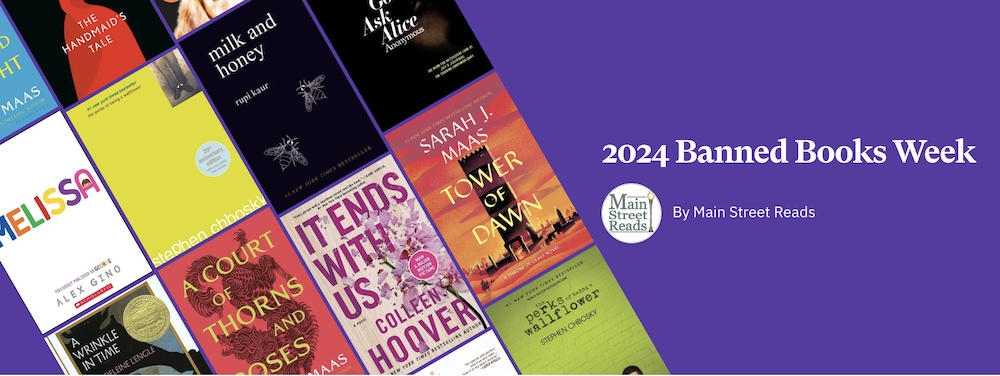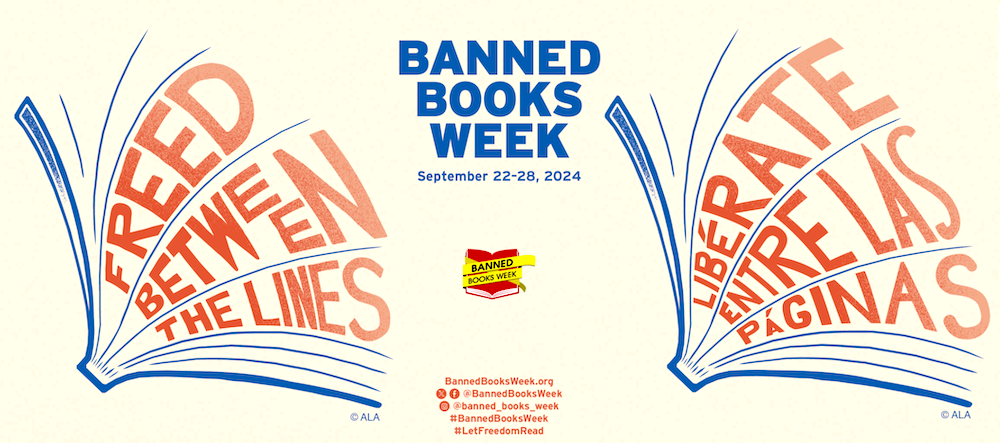Every year we join bookstores and libraries across the nation to shine a spotlight on our freedom to read with Banned Books Week. The annual event was launched in 1982 in response to a sudden surge in the number of challenges to books in libraries, bookstores, and schools.
Banned Books Week highlights the value of free and open access to information and brings together the entire book community — librarians, educators, authors, publishers, booksellers, and readers of all types — in shared support of the freedom to seek and to express ideas.
The theme of this year’s event is Freed Between the Lines.
By shining a spotlight on efforts across the country to remove or restrict access to books, we all seek to bring national attention to the harms of censorship.
So this post will give you a wee bit of background, as well as more on what’s being banned the most right now. At the store, we have a featured collection of banned books on display this week, including many being banned/challenged in South Carolina.

Here are just a few interesting facts readers may want to understand as we continue these conversations about our freedom to read:
- According to PEN America, the 2022–2023 school year saw an increase of 33% from the 2021–2022 school year. PEN found 3,362 instances of books being banned, impacting 1,557 unique titles.
- Some topics have been subject to a small but consistent trickle of book challenges for a long time: witchcraft, sex, drug use, violence,
and profanity. Almost any book depicting magic (i.e. Harry Potter) has long been subject to censorship from religious groups. Huckleberry Finn has been subject to restriction for its inclusion of racial slurs. - In recent years, the nature of these challenges has changed to become more targeted: Content by, about, and for LGBTQ+ people and people of color is particularly under attack. Of 1,648 titles banned in the 2021-2 school year, according to PEN America, 41% contain LGBTQ+ themes or characters and 40% contain protagonists or secondary characters of color.
- The book banning movement frames itself as being about parental rights, but in fact it constitutes a small number of parents restricting the rights of a larger number of people. According to The Washington Post, 11 individuals were responsible for 60% of all book challenges filed in 2021–2022.
- While many book challenges explicitly target libraries and schools, booksellers are also affected as vendors to those schools, and as champions of reading, literacy, and historically marginalized authors.
- Recent legislation poses a more direct challenge to booksellers: The ABA and indie booksellers in affected areas (most recently Arkansas and Texas) continue to mount legal challenges to prevent laws that broadly define much of the literature customers enjoy as “obscene” and make it illegal to sell or distribute those books. They’re now seeking to make their temporary injunctions permanent fixes, though we can expect this trend to continue…
UNLESS we continue to have the tough conversations. We all agree: some books aren’t appropriate for some individuals/age groups. Those can be shelved appropriately. But more important is that books be allowed their space, to continue to provide knowledge and insights to those seeking more, even when those concepts might be controversial or uncomfortable. Books are a great jumping off point for deeper discussions. They can give us a window into the experiences of others. Books can teach us empathy. And ultimately they can help us grow.
The ALA Office for Intellectual Freedom (OIF) compiles lists of challenged books as reported in the media and submitted by librarians and teachers across the country.
The Top 10 Most Challenged Books of 2023:
- Gender Queer by Maia Kobabe
Reasons: LGBTQIA+ content, claimed to be sexually explicit - All Boys Aren’t Blue by George M. Johnson
Reasons: LGBTQIA+ content, claimed to be sexually explicit - This Book is Gay by Juno Dawson
Reasons: LGBTQIA+ content, sex education, claimed to be sexually explicit - The Perks of Being a Wallflower by Stephen Chbosky
Reasons: Claimed to be sexually explicit, LGBTQIA+ content, rape, drugs, profanity - Flamer by Mike Curato
Reasons: LGBTQIA+ content, claimed to be sexually explicit - The Bluest Eye by Toni Morrison
Reasons: Depiction of rape, incest, claimed to be sexually explicit, EDI content - (TIE) Tricks by Ellen Hopkins
Reasons: Claimed to be sexually explicit, drugs, depiction of rape, LGBTQIA+ content - (TIE) Me and Earl and the Dying Girl by Jesse Andrews
Reasons: Claimed to be sexually explicit, profanity - Let’s Talk About It by Erika Moen and Matthew Nolan
Reasons: Claimed to be sexually explicit, sex education, LGBTQIA+ content - Sold by Patricia McCormick
Reasons: Claimed to be sexually explicit, depiction of rape
We’ve also created a large list of banned books here, again, including many that have been banned or are under challenge in South Carolina. Do some surprise you?

If you want to learn more about books being banned and why:
United Against Book Bans’ Book Resumes: Book Résumés help teachers, librarians, parents, and community members defend books from censorship. They detail each title’s significance and educational value and are easy to share with administrators, book review committees, elected officials, and board members.
We welcome your thoughts and we hope the info here will help spark more conversation.
‘Til then, keep reading, and we’ll see you on Main Street…
For upcoming events – CLICK HERE – lots to come including Books & Banter book club on Tuesday and a book signing with Christian fiction author T.I. Lowe next Sunday, featuring her newest hit, Lowcountry Lost.
